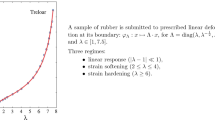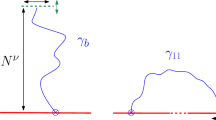Abstract
A formalism has been worked out which allows to transform any non-punctiform segment-segment potential of isolated polymer segments ε of fairly short-ranged character into the pair-potentialU operating between linear polymer chains with a certain reference to the arguments as they have been originally put forward byFlory andKrigbaum. Although no restrictions are made in the derivation as to the repulsive or attractive contribution of the segment-segment potential ε because of some known general deficiencies of theFlory-Krigbaum treatment for exclusively repulsive interaction, the resulting equations are primarily intended to describe the thermodynamic situation at and close to the θ-point where repulsion and attraction—though working at different ranges of segment separation—cancel. As the equation derived is somewhat complicated two different approximate forms have been developed: The first one is based on aTaylor series expansion retaining terms up to the fourth order which allows to characterizeU by the second and the fourth moment of the pair segment-segment distribution function, β and γ (β being the so-called binary cluster integral of segment-segment interaction, which is considered to be zero for θ-conditions). In this caseU may be represented by an expression of the general form
The second method is based on a separate integration over the repulsive and attractive ranges of ε giving the repulsive (U +) and the attractive (U −) part ofU finally after some approximations leading to an equation of the general form
In both cases the knowledge of the exact form of ε is dispensable, only β and γ—or for the second case their repulsive (β+ and γ+) and attractive (β− and γ−) parts have to be known. It is shown that the approximations are in excellent accordance with the exact form so that they may be conveniently used to describe pair potentials of polymer chains and to analyze pair potentials of segment-segment interactions under the limitations and conditions indicated.
Zusammenfassung
In gewisser Anlehnung an Vorstellung vonFlory undKrigbaum wurde ein Formalismus entwickelt, der es erlaubt, beliebige nichtpunkförmige zwischen den isolierten Segmenten von Polymerketten wirkenden Wechselwirkungspotentiale ε von einigermaßen beschränkter Reichweite in das zwischen Polymerketten herrschende PaarpotentialU zu überführen. Obwohl dabei hinsichtlich des abstoßenden und anziehenden Beitrags zu ε keinerlei besondere Annahmen eingehen, ist die resultierende Gleichung in erster Linie zur Beschreibung der am θ-Punkt bzw. in dessen Nähe vorliegenden Situation gedacht; der Grund dafür ist in gewissen bekannten Mängeln desFlory-Krigbaum-Konzepts bei der Beschreibung einer rein repulsiven Wechselwirkung zu suchen. Wegen der relativ komplizierten Form der ermittelten Gleichung fürU wurden zur Erleichterung der praktischen Handhabung zwei Näherungsformen konzipiert: Die erste beruht auf einerTaylor-Entwicklung unter Berücksichtigung der Terme bis zur vierten Ordnung, die eine Beschreibung vonU durch das zweite und das vierte Moment der Segment-Segment-Paarverteilungsfunktion, β und γ erlaubt (β ist dabei das sogenannte binäre Clusterintegral der Segment-Segment-Wechselwirkung, das unter θ-Bedingungen den Wert Null annimmt). In diesem Fall läßt sichU durch einen Ausdruck der allgemeinen Form
darstellen. Die zweite Methode geht von einer getrennten Integration über die abstoßenden und anziehenden Bereiche von ε aus und liefert nach einigen Näherungen den abstoßenden (U +) und den anziehenden (U −) Teil vonU. Dabei entsteht eine Gleichung der allgemeinen Form
In beiden Fällen bedarf es keiner genauen Kenntnis von ε; lediglich β und γ, bzw. im zweiten Fall deren abstoßende (β+, γ+) und anziehende (β−, γ−) Anteile müßten bekannt sein. Es läßt sich numerisch zeigen, daß die beiden Näherungsgleichungen nur geringfügig von der exakten Gleichung abweichen, so daß sie unter den genannten Bedingungen in bequemer Weise sowohl zur Beschreibung der Paarpotentiale von Polymerketten als auch zur Analyse von Segment-Segment Wechselwirkungspotentialen herangezogen werden können.
Similar content being viewed by others
References
Flory P. J., J. Chem. Phys.17, 1347 (1949).
Flory P. J., Krigbaum W. R., J. Chem. Phys.18, 1086 (1950).
Yamakawa H., Modern Theory of Polymer Solutions, Chapter IV. New York: Harper and Row. 1971.
Olaj O. F., Pelinka K. H., Makromol. Chem.177, 3413 (1976).
Olaj O. F., Lantschbauer W., Pelinka K. H., Macromolecules13, 299 (1980).
Olaj O. F., Makromol. Chem.177, 3427 (1976).
Olaj O. F.,Lantschbauer W.,Zifferer G., to be published.
Orofino T. A., Flory P. J., J. Chem. Phys.26, 1067 (1957).
Olaj O. F., Lantschbauer W., Ber. Bunsenges. Phys. Chem.81, 985 (1977).
Author information
Authors and Affiliations
Additional information
Meinem verehrten Kollegen, Herrn Prof. Dr.Karl Schlögl, mit den besten Wünschen zum 60. Geburtstag gewidmet.
Rights and permissions
About this article
Cite this article
Olaj, O.F., Zifferer, G. & Rhemann, H. A general formalism of deriving the pair potential of polymer chains for arbitrary interaction potentials between isolated chain segments at and close to the theta-point. Monatsh Chem 116, 1395–1412 (1985). https://doi.org/10.1007/BF00810480
Received:
Accepted:
Issue Date:
DOI: https://doi.org/10.1007/BF00810480




